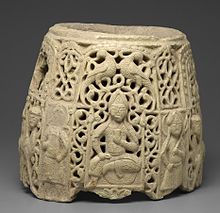![]() 10世纪, 伊朗的施釉土器
10世纪, 伊朗的施釉土器
 12世纪晚期至13世纪早期的水壶顶部
12世纪晚期至13世纪早期的水壶顶部
 中国陶器[1]
中国陶器[1]
土器,又称瓦器,是一种低级的粗陶器,有的施釉、有的不施釉[2] ,通常低于1200°C烧制[註 1][3] 。
土器的概念涵盖所有原始陶器、兵马俑、建筑砖,以及17世纪前的欧洲陶器,我们今天使用大部分的餐具也属于细土器。[4] 最早的窑可以追溯到公元前29,000–25 000年。[5][6] 中国在新石器文化期开始使用窑来烧制土器。
土器烧制时没有玻璃化[7] ,质地软。
特点
土器比白瓷、骨瓷的可塑性更好[8]。[9][10]
土器的吸水率约5-8%,[11] 强度比骨瓷、白瓷、炻器低。
橙色或红色的土器通常氧化铁含量高,被广泛用于花盆、瓷砖、工艺品和炉子。
生产
现代土器一般采用25%的高岭土、25%的球土、35%的石英和15%的长石。[12]
现代土器陶可能是比斯克瓷[13][14] ,烧制温度在1000至1150 °C之间,并施釉[15][16] 。
注释
参考文献
- ^ Women on Horseback. The Walters Art Museum. [2017-05-19]. (原始内容存档于2016-03-04).
- ^ ASTM C242 – 15.
- ^ Getty AAT, "Earthenware". [2017-05-19]. (原始内容存档于2017-12-22).
- ^ Dora Billington, The Technique of Pottery, London: B.T.Batsford, 1962
- ^ "Modern Ceramic Engineering: Properties, Processing And Use In Design."
- ^ "On the Origins of Pottery."
- ^ Combined Nomenclature of the European Union Published by the EC Commission in Luxembourg, 1987
- ^ An industry term for ceramics including tableware and sanitary ware
- ^ Whitewares: Testing and Quality Control.
- ^ Pottery Science: Materials, Process And Products.
- ^ Ceramics Glaze Technology.
- ^ Dictionary of Ceramics, 3rd edition.
- ^ Rich, Jack C. The Materials and Methods of Sculpture. Courier Dover Publications. 1988: 49. ISBN 9780486257426.
- ^ Ceramic Arts Daily – Ten Basics of Firing Electric Kilns. ceramicartsdaily.org. 2012 [16 April 2012]. (原始内容存档于2012-05-08).
- ^ Norton, F.H. Ceramics an Illustrated Primer. Hanover House. 1960: 74–79.
- ^ Frank and Janet Hamer, The Potter's Dictionary of Materials and Techniques